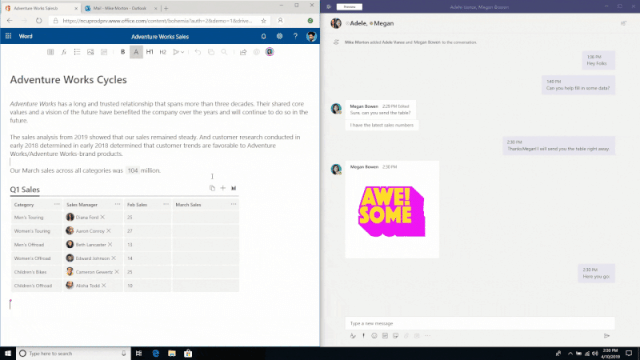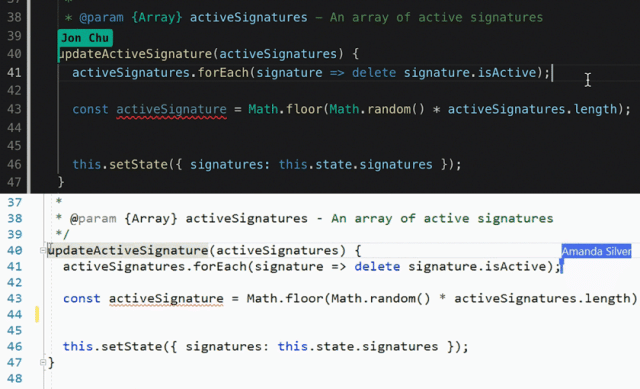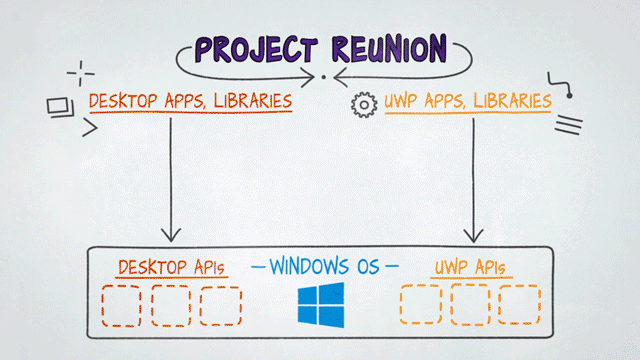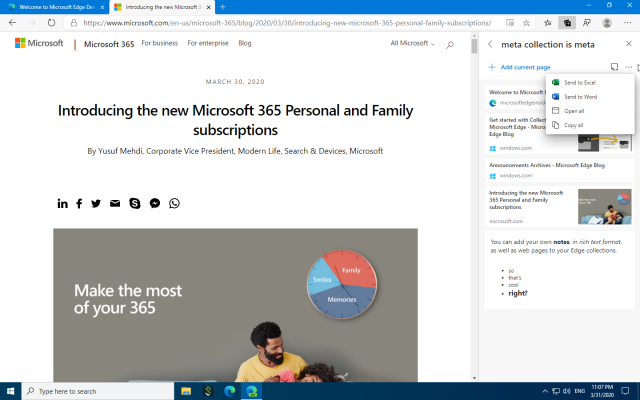
reader comments
145 with 81 posters participating, including story author
An absolute ton of new announcements has been coming out of this week’s Microsoft Build 2020 virtual conference for Windows developers. While cool, most of them are a little thin for individual reports—so we’ll get you up to speed on them in this roundup, with links out to each topic if you’re interested in more.
Windows Terminal goes 1.0
-
Windows Terminal 1.0 settings are modified in a very Linux-y way—by editing a big JSON-formatted text file, which pops up in Notepad when accessed from the Settings menu.Jim Salter
-
In addition to multiple tabs, you can open terminals in multiple panes on the same tab, using alt-shift-plus and alt-shift-minus to split vertically and horizontally.Jim Salter
-
Obnoxiously, splitting a terminal into panes forces those panes into the default shell, no matter what the shell originally in that tab was. You can get around that by running a different interpreter inside that pane, once split.Jim Salter
As Windows 10—and Server 2019—pack in more and better command-line functionality, one of the parts of the overall experience that began looking shabby by comparison is the terminal itself.
Windows Terminal seeks to change that, and it has just gone 1.0. The terminal itself is open source and is available for perusal and/or hacking at Github under the MIT license. Microsoft’s own announcement makes a point of individually crediting 14 contributors by name and acknowledging hundreds more, which is a more-than-welcome sea change for those of us old enough to have lived through the Halloween Documents era.
As for the usability of the project itself—it’s promising but still needs work, from the jaundiced perspective of a daily-driving Linux user. We like the JSON-formatted Settings file, which can be spawned in Notepad with a simple menu click. We like the native support for both tabs and panes even more—but rough edges include the fact that, under default configs, an Ubuntu/bash shell suddenly turns into two PowerShell panes if you split it.
The problem is that the pane-split hotkeys only support creating the new panes with the default profile under Terminal, and the profile includes the interpreter loaded. In addition to changing the default profile—which is very nerdily done by copying and pasting GUIDs in the settings.json—clever users can work around this limitation to some degree by simply executing a different interpreter inside the pane, after the pane itself has been opened.
Terminal 1.0 also offers somewhat PuTTY-style copy-and-paste support—selecting text in Terminal doesn’t automatically put it in the copy buffer like it does on PuTTY (you need a more Linux-y ctrl-shift-C for that), but right-clicking in another Terminal pane instantly pastes.
There are plenty more features in Terminal, most of which seem to amount for now to “shiny”—background images, animated GIFs, scanlines and glowing text (to emulate ancient green-screen CRTs), and so forth. Interested users are advised to check out the Build announcement here and the project docs here.
Azure Arc adds Kubernetes management to its CV
-
If you’re looking for a single pane of glass into Windows servers, Linux servers, Azure services, and K8s containers, here it is.Microsoft
-
Arc aims to bring cloud-centric practices into on-premises infrastructure (and developers).Microsoft
-
This Azure Data Studio screenshot includes some Arc managed database services.Microsoft
Azure Arc is—or at least will be—Microsoft’s one-stack-fits-all-services cloud-management tool.
The goal is for Arc to be as vendor- and type-neutral as possible, with support for managing Windows and Linux servers and VMs, Azure cloud services, and now Kubernetes container clusters from a single pane of glass.
It has been tempting to think of Microsoft and Canonical as locked-in partners with the emphasis on Ubuntu in Windows Subsystem for Linux, but Microsoft demonstrates continued vendor neutrality in Arc with an announcement of direct support and integration of SUSE Linux Enterprise Server—which has a larger overall footprint in Europe than it does in the United States, aside from some specialty platforms (such as SAP Hana Enterprise Resource Planning).
Although Azure Arc is still in preview (mostly public preview, with some features still in private preview) interested users can sign up to get started with it today.
Microsoft loves open source these days—here’s the Fluid framework to prove it
The Fluid framework was one of the more interesting announcements made at last year’s Ignite conference. Fluid enables document collaboration at massive scale and low latency—and it also blurs the lines between traditional document types, allowing simple and functional dynamic content embedding from one framework to the next.

Microsoft has been teasing us with Fluid integration into Office 365 apps since the framework’s initial announcement in September—this week, the company took things a step further by promising to open source the framework as well. Office 365 VP Jared Spataro announced that “Microsoft will be making the Fluid Framework open source, allowing developers and creators to use key infrastructure from Fluid Framework in their own applications.”
As exciting as this is, we’re a little worried about the follow-on social engineering implications—being able to easily embed fully responsive Office document functionality in arbitrary webpages may make it that much easier to confuse users into putting confidential data and credentials into places they shouldn’t.
A live preview of some uses of the Fluid Framework is available here, for anyone with a OneDrive for Business account.
Social hacking—integrated voice and text chat in Visual Studio Live Share

Visual Studio Live Share is sort of like Google Docs for code—you and several colleagues can live-edit the same document, with cursors highlighting each of your changes live as they happen.
Latency in VS Live Share is considerably lower than what most users will be accustomed to from Google Docs, however—and of course, the collaboration happens inside a full-featured development environment, not a simple word-processing document.
The missing piece of this puzzle, until now, has been out-of-band communication—more simply, chat, whether text or voice. Until now, developers have needed to sideload separate tools for that—perhaps using Teams in another window for instant messaging, or Mumble / Skype / Hangouts / whatever for voice. Today’s public preview brings the missing communication features directly into Visual Studio Live Share itself.
Project Reunion—you got your UWP in my Win32

One of the frustrations with developing for Windows is the coexistence of legacy and modern APIs. Use of the elderly Win32 API is for many developers more familiar, but shifting to UWP—the Universal Windows Platform—means getting access not only to Windows but also to Xbox One, HoloLens, and future hardware platforms. UWP also means an additional layer of security, which will frustrate as many developers as it delights—UWP apps can only be installed directly from the Microsoft Store.
Project Reunion, unveiled Wednesday at Build 2020, aims to heal this divide somewhat by decoupling both APIs from the Windows OS and making functionality universally available to apps built under either API. For example, Reunion makes WinUI 3 Preview 1—the modern native UI framework for Windows—available to either UWP or Desktop (Win32) apps in the same way.
Microsoft is engineering Project Reunion openly and publicly on Github, giving non-Microsoft developers a chance to directly influence the future of Windows development.
Microsoft Teams adds bookings, bots, and broadcasts
Microsoft Teams is the next-generation messaging and collaboration application from Redmond, replacing what your cynical author used to call “Lync, Skype for Business, or whatever they’re calling it this week.”
Unlike Lync and Skype for Business, Teams has a functional Web interface. This makes it a much less painful experience for those who don’t or can’t install the native client directly onto their own PC—including, but not limited to, Linux users.
The news this week is integration of appointment scheduling and shift management directly in Teams itself, along with chatbots and support for third-party streaming services. Scheduling and chatbots are exactly what they sound like—and if you’re not familiar with the streaming option, think “interview on Teams, stream to the world via Open Broadcast Studio (or similar platform).”
Pinterest integration added to Edge Collections

To the dismay of die-hard Chrome fans and Microsoft haters alike, we at Ars have been getting increasingly interested in the Edge browser. By ditching its own proprietary rendering engine and collaborating with Google on the Chromium open source browser, Microsoft gained back a lot of available personnel hours and energy for innovation.
Building atop Chromium pretty much instantly produced a snappy, usable browser guaranteed to work nearly anywhere that Chrome does; since then, Microsoft has split its focus on integration with its own platforms (such as Office 365 SSO authentication) and usability features. Collections is one of those features—simply put, it allows users to graphically, intuitively, and simply build rich “website playlists” that can be saved and perused later.
Microsoft might have lost us a bit with its latest integration, though—the browser is integrating Pinterest into its Collections feature, showing suggestions for Pinterest boards at the bottom of users’ Edge Collections, and allowing Collections themselves to export to Pinterest. Meh.
Listing image by Microsoft


